Chapter 3
Structuring the Buyer Journey
IN THIS CHAPTER
 Understanding the buyer’s mindset
Understanding the buyer’s mindset
 Unearthing your touchpoints
Unearthing your touchpoints
 Using an omni-channel approach
Using an omni-channel approach
 Creating the right content to influence a purchase
Creating the right content to influence a purchase
The guidelines for the best customer experience continually change. The only aspect that remains constant is that buyers are empowered and define their own journeys, and you need to accommodate them. Some customers like to check prices on mobile devices in retail stores; others spend hours online collecting information before making a decision. Your job is to make sure that your customer has all the information she needs to choose your product without becoming confused or annoyed.
As you begin to create your buyer journey, understand that no book or article can tell you how to map your buyers’ exact journey — so don’t be frustrated. Your customers are unique and will take the journey that makes sense to them. You can look at what your customers are doing now and extrapolate from that. However, you can’t ensure that they will take the path you choose for them. In addition, your business is unique and has its own unique way of delivering your products and services. That’s a good thing. But it makes defining the optimal experience for your customers harder.
In Book 2, Chapter 2, you take the first step in mapping your buyer journey by creating personas. In this chapter, you integrate those personas into the buyer journey. You look at the ins and outs of mapping that journey and see what content is required for each of the touchpoints along the way.
In this chapter, you find the concepts and tools you need to create a buyer journey map. But the real effort begins when you take the time to look at every step in your customer’s nonlinear path and analyze the content you need to provide. It won’t happen overnight, but if you take the time to do a thorough job, the effort will be well worth it.
Harnessing the Customer Experience
In today’s marketplace, buyers want to be able to explore information on all their devices from any location. They explore retail stores, the web, print and broadcast outlets, customer events, and so on, and all in a nonlinear process. What you need to do is to anticipate the potential contact points and provide content for each one.
But even more important than a focus on touchpoints alone is an understanding of the journey your customers take. You need to walk in their shoes to understand their behavior and what they need. This is where your personas come into play. Of course, mapping the journey using a host of procedures, systems, personas, and touchpoints can be complex. But the payoff is worth it.
Looking at the customer experience from both sides
When you and your team meet to discuss the ways you’re going to interact with your audience, you believe that you know where to engage them. Or do you? The Economist Intelligence Unit, sponsored by Panasonic, did an interesting worldwide survey in 2014 called “Creating a Seamless Customer Experience.”
The survey’s goal was to show how both senior executive and customer groups viewed service delivery to customers (http://www.economistinsights.com/sites/default/files/Creating%20a%20seamless%20customer%20experience.pdf).
A customer group was shown a list and asked, “Thinking of the ideal customer experience, which of the following elements are most important to you?” The top five elements chosen were as follows:
- Fast response to inquiries and complaints
- A simple purchasing process
- Ability to track orders in real time
- Clarity and simplicity of product information across channels
- The ability to interact with the company via multiple channels 24/7
As you can see, the customers wanted fast, simple, always-on interactions. No friction, no delay.
The same survey asked the executive group and the customer group similar questions. It asked executives, “Which of the following channels does your organization currently use to interact with customers (companies)?” It asked the customer group, “Which of the following channels do you use to learn about and compare products?”
The executives focused on a few channels that were popular with customers, but for the most part, the differences between the channels executives thought were important and those that customers chose as important were significant.The five channels that were the most at odds were:
-
Search engines: Twenty-five percent of executives say their company uses search engines to interact with their customers; 69 percent of the customers say they use this channel.
Missed content opportunity: Search engines are most often used in the early stages of the buyer journey. If customers are searching and your contentisn’t optimized for search engines, you won’t even be on their radar.
-
Friends and family: Zero percent of executives say their company communicates with customers through their family and friends; 51 percent of customers say they consult family and friends.
Missed content opportunity: Obviously, this is a big misstep. Recommendations from trusted friends and family are a big factor when deciding to make a purchase. These executives have made no attempt to reach the customer’s influencers on social networks.
-
Independent websites: Nineteen percent of executives say they use independent websites to interact with customers; 46 percent of customers say they use these sites.
Missed content opportunity: This mistake is a hard one to understand when you think about all the guest posting and cross promotions available to most marketers.
-
Email: Sixty-seven percent of executives say they use email to interact with customers; 38 percent of customers say they use this channel.
Missed content opportunity: This one requires some understanding of what kind of emails executives are referring to. If executives use personalized emails to send targeted content to buyers, they have a good chance of getting the buyers’ attention. Obviously, buyers would have given their email address with the expectation that they would receive emails. If the executives are sending what you would consider spam, that is, content that was neither requested nor desired, these emails would rank very low among customers.
-
Phone: Fifty-five percent of executives say they use the phone to interact with customers; 24 percent of customers say they use this channel.
Missed content opportunity: Obviously, this is a tactic that should most often be used in the later stages of a buyer journey and only if the buyer has given permission. Cold calling (that is, without permission) just doesn’t fit with marketing tactics.
Benefitting from an omni-channel approach
One key benefit of mapping your buyer’s journey is that it helps you understand where to put your greatest effort. So how do you go about putting your plan together? Start with an omni-channel mindset. This means that you have to think of all the different customer touchpoints as one integrated journey. No more multi-channel approach; instead, all the channels are connected.
Marketers make the common mistake of thinking about their buyer journey as a discrete set of linear steps. For example, marketers create a content plan for their social media channels and another for their website. They forget that consumers are jumping from one channel to another, from different locations and on different devices. They aren’t giving any thought as to how they fit together. That’s your job.
You need to provide prospects with a frictionless journey that doesn’t require an online road map to traverse. If buyers want to look at your Facebook page on their mobile, or look at your website in your bricks and mortar store, you need to make sure they’re viewing a consistent message that ties all their activity together.
This idea probably makes sense to you because that’s how you buy products, regardless of whether you’re making a B2B purchase or buying a sofa for your home. In fact, according to Outerbox (https://www.outerboxdesign.com/web-design-articles/mobile-ecommerce-statistics) more than half of all Internet shopping is conducted on a mobile device. When shoppers decide to buy, where they are or which channel they use doesn’t matter.
Here’s an example: Imagine that your customers are looking at your website and see something they’re considering purchasing. They want to look at it in your store to make sure that it’s exactly what they want. When they walk into your store, you can trigger a discount coupon on their smartphone. Then they can buy using that coupon. When they return home, they can check your website to look at the shipping arrangements. If you don’t have a bricks-and-mortar store, your customer will still want to shop where and when it’s convenient for them, so you have to create a buyer’s journey that supports that path, too.
Uncovering Commercial Intent
Given all the concepts you have to deal with for the buyer journey, you probably don’t want to hear about keywords, too. But it’s important to understand how they fit in when you’re constructing your buyer’s journey. When you think about your keywords, you probably choose ones that provide your users with the information they’re looking for. Before you do that, however, you should consider the ones you need when focusing on the buyer journey.
The keywords that people use tell you their intent — that is, what they’re trying to accomplish. When you create your keyword list, you should consider buyers’ commercial intent. That means that you want to focus on keywords people use when they intend to buy things.
Here’s how this works. People undertake basically three types of searches:
- Informational searches: Users perform this type of search when they’re primarily looking for information. Their searches contain such words as “how do I” or “where can I.” For example, the results of a Google search for “how do I create content” is shown in Figure 3-1.
- Navigational searches: Users conduct this kind of search when they know exactly what they’re looking for. For example, if they want to read articles on Ian Cleary’s blog, they type razorsocial, as shown in Figure 3-2.
-
Transactional searches: User intent here is to buy something. This is the type of keyword that you want to focus on. You want to ensure that the people who want to buy can find you.
Along with words such as buy, the category of product appears. For example, you see searches such as “buy organic baby food online” or “ship organic baby food.” The results for a search on Google for “buy organic baby food online” are shown in Figure 3-3.
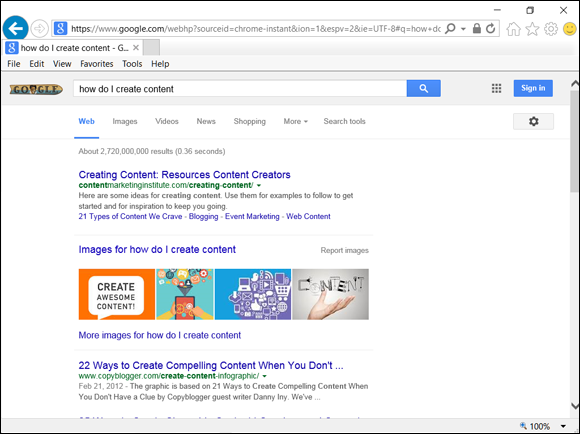
FIGURE 3-1: Google results for “how do I create content.”
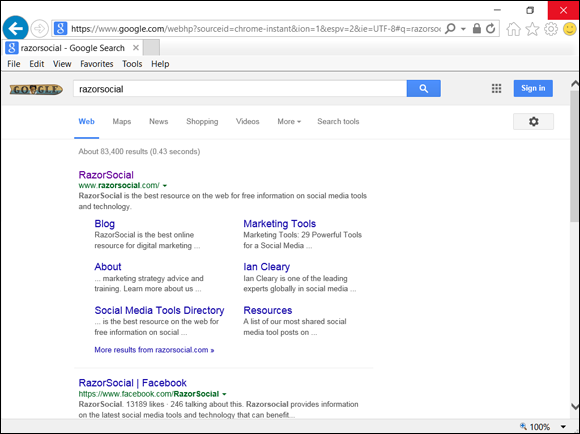
FIGURE 3-2: RazorSocial.
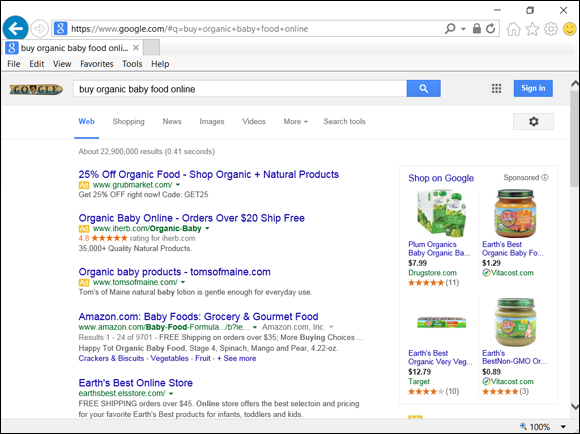
FIGURE 3-3: Google results for “buy organic baby food online.”
Make sure to use transactional keywords when constructing your content for your buyer journey.
Defending Against Competitors
Closely following your competitor’s efforts is key to understanding what your prospects will encounter in their research. If you know that your competitors have provided comparison charts and data sheets, you should do so, too. You want to make sure to do a good job of demonstrating how choosing you is the better option. You need to cover all aspects of the buyer’s journey to win the sale.
Researching competitors
You’ve spent time learning about what your competitors are doing. But you can’t effectively compete if you don’t know what your customers know about your competitors. You want to know what they do well and how they fall short. Your job is to surpass their marketing efforts and win the sale.
Your most effective way of winning the sale is to look at your competitors through your customer’s eyes. Your customers don’t care how much your competitors spend on advertising, syndication, and content creation. All they know is how well their needs are met.
In the past, doing competitive analysis was a costly endeavor. Corporate spies, focus groups, and lots of wining and dining of staff went into getting information. Nowadays, you can do a host of things online to understand your competitors’ strategy. The information is digital and ready to be scooped up.
Here are some things you can do:
- Analyze your competitors’ website. Your staff probably looks at your competition’s media properties on a regular basis. And they probably know more than a company’s customers do when the competitor redesigns the website or changes product features.
-
 You don’t want to overdo this analysis. Keeping too close a watch on competitors can prevent you from focusing on your actual customer’s desires.
You don’t want to overdo this analysis. Keeping too close a watch on competitors can prevent you from focusing on your actual customer’s desires. One mistake companies make is to try to clone their competitor’s site design and approach everything in a similar way. They do this in the mistaken belief that the customer will choose them because their product is simply better. Unfortunately, that’s not how people think. They take into account the whole brand experience. Someone may pick your competitor for reasons that have nothing to do with the actual functioning of the product. Remember to tell your customer what’s unique about your brand.
One mistake companies make is to try to clone their competitor’s site design and approach everything in a similar way. They do this in the mistaken belief that the customer will choose them because their product is simply better. Unfortunately, that’s not how people think. They take into account the whole brand experience. Someone may pick your competitor for reasons that have nothing to do with the actual functioning of the product. Remember to tell your customer what’s unique about your brand.To look at actual data about your competitors, you can check out tools like these:
- SimilarWeb (
http://www.similarweb.com): See Figure 3-4. You can put in competitor domains and see traffic statistics, referring sites, bounce rate, and more. - Ahrefs (
https://ahrefs.com): See Figure 3-5. This tool not only has lots of great data but also lists the top ten competitors for the domain you enter. Put in your competitor’s domain and see what you find.
- SimilarWeb (
- See what their customers say on social media platforms. You can do this at both a high level and a granular level. You can look directly at competitors’ social media sites to see what their customers are saying. Then you can use data analysis tools to compare your sites.
- Analyze their content offerings: See the next section for how to analyze competitors’ content. (You can also use SEMrush and MozBar, again in the next section, to get competitive data.)
- Download their product specifications and online resources: Obviously, you can go to a company’s website and download anything that any user can.
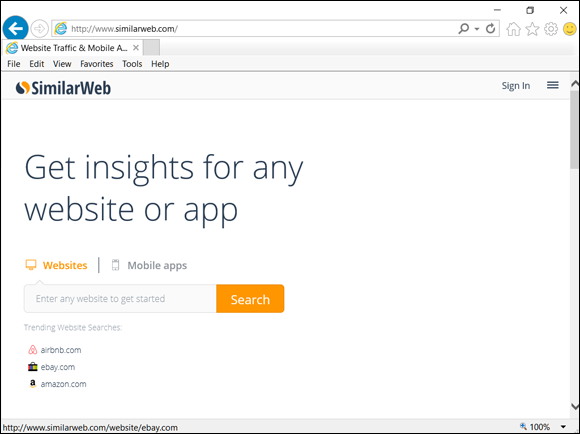
FIGURE 3-4: SimilarWeb.
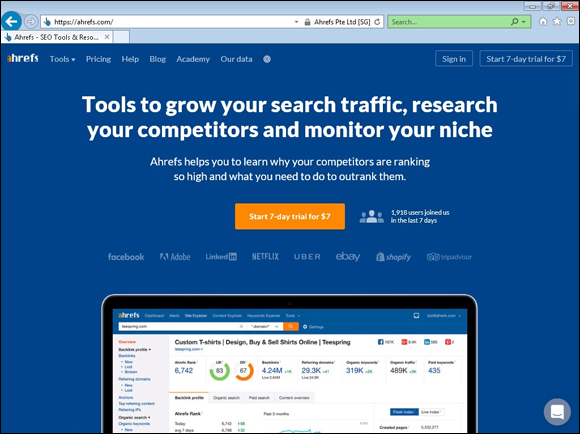
FIGURE 3-5: Ahrefs.
The key to doing a good job with competitive research is to focus on what your customers care about. Next, you consider how to analyze competitive content so that you can improve your own.
Analyzing your competitor’s content
To understand what your competitors are offering, you need a reliable way to analyze their content. In his article “An Epic Guide To Creating Epic Content,” (http://robwormley.com/how-to-create-epic-content; see Figure 3-6), Rob Wormley recommends three effective tools that you can use to learn about your competitor’s content.

FIGURE 3-6: Rob Wormley’s blog.
The tools are
- BuzzSumo: Go to BuzzSumo (
http://buzzsumo.com) and type your competitor’s domain. You see a list of the most popular posts for the date range that you specify. Analyze as many as you need to make a solid determination of what content is resonating with that audience. - MozBar: To see the title and meta description for the post, use the MozBar for your browser, as shown in Figure 3-7 (
https://moz.com/tools/seo-toolbar). - SEMrush: To see the top keywords that the content ranks for your competitor, go to SEMrush (
http://semrush.com), shown in Figure 3-8. Put in the competitor URL and scroll down the page to see the top organic keywords. You can also see a lot of other key information.

FIGURE 3-7: MozBar.
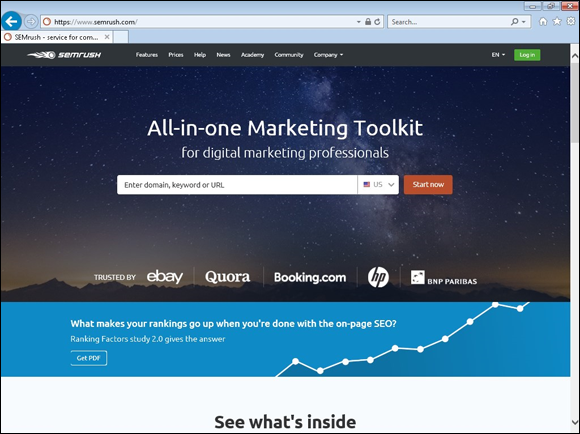
FIGURE 3-8: SEMrush.
Go through and evaluate the content for completeness and novelty. This evaluation should give you a good start on analyzing your competitor’s content. After you have evaluated your top competitors, evaluate your own content to compare it. You can use the compare function in the settings in BuzzSumo in Tools⇒ domain vs. domain.
Identifying the Stages of the Buyer Journey
To reach your prospects, you need to understand what content they need to purchase your product. Rather than send generic content and hope for the best, you need to create content that targets the buying stages your prospects pass through.
Understanding the buying process and journey map
The typical buying process is divided into three stages: awareness, consideration, and decision. Because your job is never really done, you may find two more useful: purchase satisfaction and ongoing use. If you don’t support your customers, you will lose them.
Here are the five stages of the buyer journey:
- Awareness: The prospect acknowledges a problem and begins to research a solution.
- Consideration: The prospect looks at options and competitors and narrows down her choices.
- Decision: The prospect chooses your product and looks at your specific buying details to determine customer support, shipping, and any other follow-up.
- Satisfaction (post purchase): Buyers want to feel that they made the right choice, and they want information that confirms that choice. This information can include usage tips and other ways to use the purchase that they didn’t know about.
- Ongoing use: Buyers want to feel supported in their continued use of the product and may become advocates if their relationship with the seller is nurtured correctly.
So now that you know the stages that buyers pass through, you need to figure out where they go to get the information they need. For this purpose, you create a journey map.
Journey maps come in all sizes and styles. You can make them highly detailed or just cover the basics. What most journey maps lack is the marriage of your personas with your expected journey.
As the buyer journey has evolved, marketers have been realizing that creating generic content for prospects in each stage is a waste of time and money. You need to speak to your specific buyer. The customer is expecting something more personalized, geared to her tastes and sensibility. You have done the hard work of creating personas (or see Book 2, Chapter 2 if you haven’t). Now it’s time to use them.
Perhaps when you first got started marketing your content, you created a bunch of blog articles that you thought your audience would like. Many times, you guessed wrong, and your traffic numbers indicated that. Then you got a bit savvier and started to look at what content actually drove engagement, whereupon you created more of that kind of content. By creating personas, you took the next step in giving your audience the content they really need. Now, by applying those personas to the buyer journey, you’re accelerating the buying process.
Benefitting from the journey map
If you wonder whether creating a journey map is worth the time and effort, think about the fact that it keeps you and your organization focused on the specific needs of your customer. That’s critical. Some other key benefits of journey maps are that they
- Help you determine what your priorities should be. You know that you will never meet every customer need, create every piece of desirable content, or always make the sale. There’s just an overwhelming amount of work that needs to be done. But you are going to try. To get a handle on your priorities, a journey map shows you the actions that will have the most impact on the customer experience.
- Get everyone on the same page. A visual map lets everyone know what the goals are and why they exist. Everyone can see how everything fits together, and team members can agree or disagree right up front so that buy-in can be established.
- Let you see where your customer experience is broken. An interesting thing can happen as you map your buyer journey. You can see where your path breaks down. If you don’t have sufficient content for each stage, that lack will become apparent and you can remedy it.
- Show you what each department needs to do to collaborate effectively with one another. A visual map of the buyer journey helps staff members move out of their silos and collaborate effectively. It’s hard to stay isolated when you know what the rest of the team is trying to accomplish.
- Help you determine the content needed for each stage of the journey. Obviously, you need to match content to each point in the journey. See the next section to find out how.
So, what are the key items you want on your journey map?
- Buyer’s stage/goal: The possible stages that your customer may go through are in the section “Understanding the buying process and journey map,” earlier in this chapter. You can add those to your map if they fit your products. Also include the specific goal statement for your product or service.
-
Persona: If you followed along in Book 1, Chapter 2, which covers creating personas, you have them ready to go. If you haven’t created your personas yet, doing so is important because you need to identify on the map the persona you’re targeting.
 When you complete your persona research, you should be able to note what special concerns and needs your persona has right on your map.
When you complete your persona research, you should be able to note what special concerns and needs your persona has right on your map. - Touchpoints: See the next section to determine how to apply touchpoints to the map.
Focusing on content for each part of the journey
As mentioned previously, beginning your journey map is a complex undertaking. Table 3-1 lists possible choices.
TABLE 3-1 Content for the Buyer Journey
|
Buyer Stages |
Personas |
Potential Touchpoints |
Suggested Content Types by Stage |
|
1. Awareness: Identifies a problem and does a broad search |
Example: Jane Brown |
Search engines on mobile and computer, brand websites, blogs, landing pages, social media platforms, ads, influencers |
WOM, ebooks, reports, photos, infographics, blogs, articles, recommendations, video, influencer content, testimonials, PR |
|
2. Consideration: Narrows options and looks at specific products and pricing |
Personas |
Brand websites, blogs, landing pages, social media, rating and review sites, ads, influencers, email |
Product tour, demos, free trials, free samples, interviews, testimonials, pr, webinars, videos, white papers, case studies, pricing, webinars, recommendations |
|
3. Decision: Makes final comparisons and chooses your product |
Personas |
Customer service on social media and website or in store, mobile, salesperson, email |
Product specifications sheets, buyer’s guides, comparison charts, webinars, a look at the checkout process, shipping info, payment options, online customer support options |
|
4. Satisfaction: Felt immediately after purchase |
Personas |
Customer service, social media, website, mobile, email |
Email follow-up, tech support, community, social media, webinars, online training |
|
5. Ongoing Use: Uses product and could become a potential advocate |
Personas |
Customer service, social media, website, mobile, email |
Free tips, online training, conferences, webinars, video, support, in-person meetings |
To create a journey map with content, follow these steps:
- Choose the buyer stage.
- List the specific persona you’re targeting.
- List the touchpoints by thinking through the path you think this persona would take.
- List the type of content you need to create to support that path.
Another helpful way to understand how your prospect thinks about content in each stage of his buying journey was presented by Mathew Sweezey from Salesforce.
He states that when a prospect begins his search for product information, he thinks about the following:
- In the first phase (the awareness stage), he considers himself and how to do his job better. He looks at content such as blogs, articles, and industry blogs.
- In the second phase of his research (the consideration stage), he looks for social proof — that is, how others benefited. This includes content like case studies, interviews, and videos.
- In the final phase (the decision stage), he looks at content about your company to help him decide whether you’re the right choice. This includes content such as buyers’ guides, comparisons, and sales sheets.
As you’re creating your content, think about whether customers are thinking about how the product impacts them (what they think), social proof (what others say), or you (what you say).
Personalizing Your Content
Forbes Magazine has named personalization one of the top trends and said that “Personalization is not a trend. It is a marketing tsunami.” Are you ready for the onslaught? Can you provide the type of personalized experience that your customers expect?
Personalizing content is a tricky business. Customers want to have a personalized experience but also want to feel that their privacy is being respected. This is a fine line to walk. But walk it you will, because consumers no longer tolerate content that isn’t matched to their needs.
One of the most common examples of personalization is Amazon’s ability to recommend products and prime videos (if you’re a Prime member) that most Amazon subscribers feel is very accurate. Target has also created algorithms that can predict users needs even before they know them. For an interesting example of this, see (https://blog.hubspot.com/marketing/marketing-personalization-examples).
This statement is not an exaggeration. A study conducted by Janrain, a company that uses proprietary technology to help companies find new users on social media (https://www.janrain.com/), found out that when they asked respondents how they would respond to content that wasn’t relevant to them. Seventy-five percent of the respondents said that they would leave a website if they were shown ads or content that didn’t align with their interests. Fifty-seven percent said they would be willing to give some personal information if it was used responsibly for their benefit. Additional findings indicated that consumers are unwavering in their desire to see content personalized for them and wouldn’t hesitate to leave a site that didn’t cater to their needs.
Larry Drebes, founder of Janrain, said that “[c]onsumers have reached the tipping point when it comes to being shown content that isn’t relevant to them. It’s a wake-up call for brands to fix this problem or risk losing customers and prospects.” As you can see, your customers will only get more insistent about personalized content.
If you work for a company that doesn’t use personalization technology, that’s not surprising. According to a study done by Econsultancy and Monetate, a company that provides personalization services to organizations, more than half (56 percent) of companies don’t use it on their websites. In fact, 72 percent of the respondents said they know it’s important but that they “don’t know how to do it” (http://info.monetate.com/CROnlinePersonalisationUS_Research.html?utm_source=M-W-Blog&utm_campaign=R-Personlisation).
So if you’re interested in getting started with personalization, what should you consider?
- Your organization’s state of readiness: Is your organization prepared to do the work and allocate the budget necessary to do a good job of personalizing your owned media? Does management believe it’s a good idea?
- The strength of your personas: Do you have confidence that you can use your personas as the framework for your personalization efforts? If you don’t have personas or have given them short shrift, you’re not ready to put a personalization program into practice.
- Your data collection efforts: Do you have a customer relationship management (CRM) system or other data collection management tools to ensure that you have the data you need? Will you be able to assess the effectiveness of your efforts?
- Your email capabilities: Can you send personalized emails with your current system and track the results?
- Your mobile messaging efforts: Will you be able to reach consumers with your offers via their mobile devices?